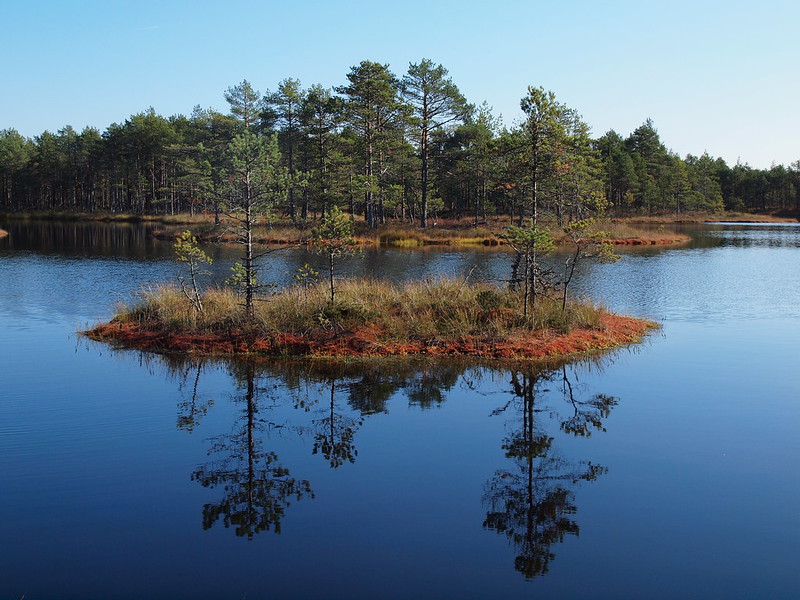Why Estonia’s ancient peatland is key to its climate future
Drained and degraded by decades of mining, Estonia’s primeval peatland emits monstrous amounts of CO2. But a massive volunteer-led project is restoring it to the miraculous carbon sink that nature intended.
T
hey may not be the first thing you think of when you picture the climate fightback. They might lack the drama of a rainforest or the pathos of an orangutan sanctuary. But the humble peat bog could yet play a key role in efforts to slow global heating – and in Estonia, efforts are underway to let mires demonstrate their secret superpowers.
This autumn, volunteers have been braving the damp in Lahemaa National Park in northern Estonia to restore a mire known as Laukasoo. Lahemaa was the first area in the Soviet Union to be granted designated status in 1971 – but only after the occupiers had spent decades draining the bogs to mine the valuable peat that lay beneath the waterline. By refilling the 10-metre drainage ditches, the project – an EU-funded collaboration between the Estonian Fund for Nature and the University of Tartu – aims to roll back the damage done to these distinctive primeval ecosystems.
Mires are natural carbon sinks that have the potential to become ruinous greenhouse gas emitters. Despite occupying only 3% of the globe’s land surface, peatland locks underground more than double the carbon than is stored in all the world’s forests. Peat is composed of dead organic material, chiefly sphagnum moss, prevented from decomposing by waterlogged, acidic conditions. It accumulates incredibly slowly, at a rate of 1mm a year, and since Estonia’s bogs enjoy 3–6 metres of peat on average, this is some of the oldest organic landscape in the country, a prehistoric relic lying just below the surface.

Kõnnu-Suursoo is bog in Harju County, Northern Estonia. Photo by Anita/Flickr
Drained and dried, however, peat is also a valuable natural resource, burned as fuel or spread as fertiliser. It was mined as a cottage industry for centuries before the Soviets scaled up production, draining thousands of marshes nationwide in a bid to create farmland. Today, Estonia still mines up to 1.5 million tonnes a year of the rich, dense deposit, selling most of it to the growers of western Europe. (Almost 40% goes to the Netherlands’ flower industry.)
Aside from the cosmetic affront to Estonia’s ancient, mystical landscape, there’s a practical problem. When the bogs dry out, the covering of sphagnum moss dies, allowing bacteria to begin decomposition. As several millennia of compressed organic matter rots, the bogs leak CO2 on an industrial scale. In Estonia, it’s an issue. The degraded peatland emits 8 million metric tonnes of CO2 a year, which in a nation of 1.3 million people accounts for a third of all carbon output, more than its cars and trucks put together.
The LIFE Mires project
Restoring the peat, then, is key to Estonia’s climate action plan. Launched in 2015, the LIFE Mires project draws on €2 million of EU funding to rehabilitate more than 50,000 acres of abandoned bogs in 89 different locations. As an added benefit, the restored bogs will tempt back fauna like wood grouse, moor frogs and dragonflies, along with some of Estonia’s native flora, a quarter of which grows only in mires.
And it is this crucial work that the volunteers of Laukasoo are here to accomplish. To grow, peat needs two elements: a high water table and native sphagnum moss, which is regarded as a ‘habitat manipulator’, capable of soaking up and releasing moisture to keep bogs waterlogged. Once the water regime is restored, bog mosses can be replanted near to the blocked drainage ditches and begin to colonise the surface. Though the project is technically climate mitigation, not adaptation, it prepares Estonia for a future in which net zero emissions are a necessity, not a requirement.
Scheduled to run until the end of 2021, LIFE Mires has set its sights on refilling a combined 240km of ditches. Not all of the work will be done by hand, but the volunteers are nevertheless key to the enterprise. After centuries of being feared and maligned, Estonia’s mires are enjoying a new dawn at the centre of the nation’s eco-consciousness, with the more accessible bogs crisscrossed by raised walkways and guided tours. The inclusion of 50 volunteer camps comprising some 500 volunteers was a calculated step to add an educational element and generate enthusiasm for Estonia’s conservation efforts. The outreach extends to study days for schoolchildren and the establishment of LIFE Mires trails. (A fairytale book for children follows the adventures of two ogres, Kalli and Modrise, in an informative quest over the bogs.)
When it comes to water, the project has the weather on its side. Estonia is a wet country, and it’s about to get wetter: precipitation could increase 20% by the end of the century. However, temperatures are also rising faster than the global average, and warmer atmospheric conditions could double emissions from the degraded peatland. As the nation adapts to the climate of the future, it has never been more crucial for Estonia to look to its ancient past, and the bogs where it all began.
The ideas presented in this article aim to inspire adaptation action – they are the views of the author and do not necessarily reflect those of the Global Center on Adaptation.